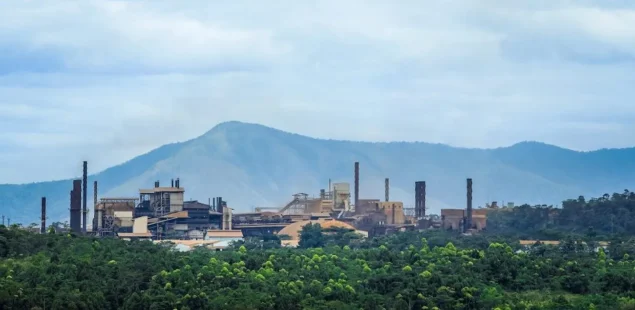
Global platinum production overview
Platinum is a vital precious metal with applications in automotive catalysts, industrial processes, and jewelry. In recent years, its role in green hydrogen technologies and fuel cells has expanded its strategic value. Global platinum production reached approximately 236 metric tons in 2024, with South Africa accounting for over 70% of the output. Russia, Zimbabwe, and Canada also contribute smaller but important volumes.
South Africa’s Bushveld Complex remains the world’s largest source of platinum group metals (PGMs), with vertically integrated platinum mining companies operating extensive underground and open-pit projects. However, power shortages, labor disputes, and aging infrastructure continue to constrain production growth.
Market dynamics have shifted in response to weakening diesel vehicle demand (a traditional platinum consumer) and growing interest in hydrogen-powered vehicles and industrial decarbonization. These shifts are redefining the long-term demand outlook for platinum and making the sector increasingly attractive for strategic investors.
Leading platinum mining companies
The platinum sector is dominated by a handful of large, diversified mining firms with extensive operations and integrated supply chains:
Anglo American Platinum (Amplats): The world’s largest platinum producer, headquartered in South Africa. Amplats operates key assets such as Mogalakwena, the world’s largest open-pit platinum mine, and Amandelbult. In 2024, the company produced approximately 1.86 million ounces of platinum. Its integration across mining, refining, and marketing makes it a cornerstone of global supply.
Impala Platinum (Implats): Another major South African platinum miner with operations in Rustenburg, Marula, and Zimbabwe (Zimplats). Implats produced approximately 1.38 million ounces of platinum in 2024 and has been expanding its portfolio through acquisitions and brownfield developments.
Sibanye-Stillwater: Originally focused on gold, Sibanye has become a key player in PGMs, particularly after acquiring the Stillwater mine in Montana, USA — a primary palladium mine with platinum as a by-product. It has diversified geographically and is actively investing in battery metals.
Northam Platinum: A mid-tier South African company with growing output, Northam owns the Zondereinde and Booysendal mines. It has gained investor interest for its efficient operations and steady production growth.
These platinum companies control much of the world’s production and are central to market pricing and supply chain stability. Their operational performance is closely watched by analysts and institutional investors.
Emerging players in the platinum sector
While the platinum market is largely controlled by South African giants, several emerging mining companies are making strategic moves to enter or expand within the sector:
Tharisa plc (South Africa): Although best known for its chrome operations, Tharisa has a growing PGM portfolio, including the Karo Platinum project, with ambitions to increase its platinum footprint.
New Age Metals (Canada): Focused on PGM exploration in North America, particularly the River Valley Project in Ontario — one of Canada’s largest undeveloped primary PGM resources.
Ivanhoe Mines (Canada): Through its Platreef project in South Africa, Ivanhoe is developing a high-grade, long-life PGM mine with modern mechanized operations and a focus on sustainability.
African Rainbow Minerals (South Africa): ARM is a diversified miner with exposure to PGMs through its stake in Modikwa Platinum Mine and other joint ventures.
These emerging platinum mining companies offer high growth potential but face challenges in funding, regulatory approvals, and infrastructure. Nonetheless, they provide critical diversification in a supply-concentrated industry.
Investment opportunities and risks
Platinum companies present a mix of opportunity and complexity for investors seeking exposure to precious and strategic metals:
Opportunities:
- Rising demand from green hydrogen, fuel cells, and industrial decarbonization.
- Supply constraints in South Africa could support prices if demand rebounds.
- Exposure to PGMs provides a hedge against inflation and currency risk.
Risks:
- Operational instability in South Africa: power outages, labor unrest, and regulatory challenges.
- Demand uncertainty due to EV shift and reduced diesel vehicle production.
- Price volatility driven by speculative trading and macroeconomic shifts.
Investors should prioritize platinum mining companies with robust cost structures, diversified operations, and exposure to future-facing applications such as hydrogen and fuel cells. Analyzing debt levels, political risk exposure, and forward contracts is also crucial in assessing long-term performance.
Technological advancements and sustainability
Platinum companies are increasingly investing in technology and sustainability to improve operational resilience and appeal to ESG-conscious investors:
Mechanized mining: Companies like Ivanhoe and Amplats are pioneering mechanized and automated mining methods to improve efficiency and worker safety in deep-level mines.
Water and energy management: Sibanye-Stillwater and Northam have implemented advanced water recycling systems and are integrating renewable energy sources to reduce carbon intensity.
Tailings reprocessing and circular economy: Leading firms are investing in tailings recovery and secondary PGM production to lower environmental impact and increase metal yield.
Carbon reporting and governance: Platinum mining companies are aligning with international frameworks such as the Task Force on Climate-related Financial Disclosures (TCFD) and ESG ratings to improve transparency and stakeholder trust.
These technological shifts are not only enhancing productivity but are also critical to maintaining social licenses to operate and securing long-term investor capital.
Future outlook for the platinum industry
The future of the platinum industry is increasingly linked to energy transition trends and industrial decarbonization. While traditional demand from the automotive sector may plateau, emerging applications in hydrogen fuel cells, electrolysis, and aerospace offer promising growth avenues.
The Hydrogen Council estimates that platinum demand from hydrogen technologies could grow three- to fourfold by 2040. Additionally, tightening supply conditions in South Africa and geopolitical uncertainties in Russia could support medium-term price appreciation.
However, the industry must address challenges such as mine depletion, energy constraints, and high capital expenditure requirements. Platinum companies that can innovate, diversify geographically, and align with decarbonization trends will be best positioned to lead the market.
FAQ
What company mines the most platinum?
Anglo American Platinum is the world’s largest platinum producer, responsible for approximately 1.86 million ounces annually. Its assets in South Africa, especially the Mogalakwena and Amandelbult mines, are among the most productive globally. As the flagship of Anglo American’s PGM portfolio, Amplats plays a central role in global supply chains.
What are the best platinum stocks to buy?
Top platinum stocks include Anglo American Platinum, Impala Platinum, Sibanye-Stillwater, and Northam Platinum. These companies offer robust production volumes, vertically integrated operations, and exposure to rising industrial demand. For speculative investors, juniors like Ivanhoe Mines and New Age Metals offer high-risk, high-reward potential linked to new project developments.
Who is the biggest producer of platinum?
South Africa is the largest national producer of platinum, contributing over 70% of global output. Among companies, Anglo American Platinum holds the top position, followed by Implats and Sibanye-Stillwater. These firms operate large-scale, high-grade mines in the Bushveld Complex — the richest PGM resource globally.
What are the big 4 mining companies?
The “Big 4” diversified mining companies are BHP, Rio Tinto, Glencore, and Anglo American. While they are leaders in commodities like iron ore, copper, and coal, they are not dominant in platinum mining. Instead, the platinum sector is led by specialized South African companies such as Anglo American Platinum, Implats, and Sibanye-Stillwater.



